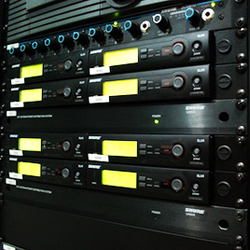In late September, the U.S. Federal Communications Commission (FCC) announced that TV Band Devices (TVBDs) – unlicensed next-generation consumer products working on new types of “Super WiFi” – will be allowed to operate in the unused UHF core TV spectrum or “White Spaces.”
At the same time, two 6 MHz TV channels are reserved for the use of unlicensed wireless microphone systems, and there’s a secondary haven for wireless mics in the low end of the UHF spectrum.
Specifically, the FCC’s “Second Memorandum Opinion & Order” states that the first channels on either side of TV channel 37 that are unoccupied by broadcast television stations will allow protected operation of an estimated minimum of 12 to 16 wireless mics. TV channel 37 is the unused channel that is already reserved for radio astronomy.
The second safe haven for wireless mics is in the lowest UHF channels, TV 14 to 21 (470-512 MHz), where mobile TVBDs are prohibited.
In addition, fixed TVBDs aren’t allowed in TV channels adjacent to broadcasters.
For example, in my home base of Jacksonville, FL, WTE V TV channel 19 provides a safe haven for wireless mics in TV channels 18 and 20 (494-500 and 506-512 MHz).
In many major metropolitan areas there’s at least one broadcaster below TV 21 providing one or two 6 MHz safe havens.
In 13 FCC-defined “major economic areas,” the requirement that fixed TVBDs avoid channels adjacent to both TV stations and public safety agencies opens up even more spectrum between 470 and 512 MHz.
These areas are the cities of Boston, Chicago, Cleveland, Dallas, Detroit, Houston, Los Angeles, Miami, New York, Philadelphia, Pittsburg, San Francisco and Washington DC, and they will have two to four safe channels for wireless mics.
Several manufacturers recently added new frequency groups to one or both sides of TV 37, or below TV 21. Unless you plan on making a living providing large-scale wireless systems, there’s not a huge need to buy new systems outside of the adjacent-TV 37 or sub-TV 21 safe havens.
Large event managers, licensed and unlicensed alike, will need to register wireless equipment for their events in the FCC’s database 30 days in advance, and must include specific days and times when the equipment will be used.
Submitted RF plans must show that all available protected spectrum will be used at the full capacity of 6 to 8 units per TV channel in order for the FCC to protect the use of additional spectrum for wireless mics beyond the safe havens.
Non-compliance will result in being removed or not being allowed to register in the database. This means that mid- and lowband safe haven UHF wireless system inventory will always be in demand, as it will be needed for both large and small events.
Finally, I’d like to point out that there’s a large tax benefit available for 2010 that will get much smaller for 2011.
Under the HIRE extension to Section 179 of the U.S. Internal Revenue Code, up to $250,000 of equipment purchases can be written off, but the maximum deduction drops to $25,000 in 2011.
In order to receive a tax benefit for 2010, you must buy equipment and put it into service before year’s end.
Given that there’s a small number of desirable frequency groups going forward, waiting until the end of December may find your new equipment back-ordered and therefore making you unable to claim that benefit.
As always, be sure to get your tax – and wireless – advice from qualified professionals.
Mark Frink is editorial director of Live Sound International.
















